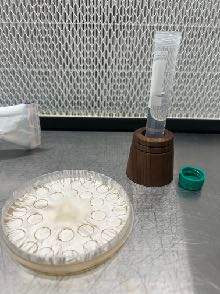Mushroom cultivation, like any biological process, is subject to senescence, or the natural aging of genetics over time. As a strain is repeatedly cloned, its genetic information can degrade, leading to slower growth, mutations, or complete loss of vigor.
The best way to avoid senescence is by periodically returning to spores, ensuring genetic diversity and maintaining long-term culture viability. This article will explore the causes of senescence, strategies for genetic preservation, and how to properly store cultures for long-term use.

What is Senescence in Mushroom Cultivation?
The Impact of Genetic Aging
Senescence is the gradual loss of genetic strength in mushroom cultures due to repeated cloning and inbreeding. When a culture is cloned multiple times without introducing fresh spores, it accumulates mutations, leading to:
- Reduced colonization speed
- Weaker fruiting bodies
- Higher contamination risks
- Lower yields over time
Growing from spore prints rather than repeatedly cloning ensures genetic diversity, making future generations more resilient and productive.
How to Prevent Senescence
- Use spores from the first flush to introduce new genetic variation.
- Limit excessive tissue culturing, which can degrade genetics over time.
- Store cultures properly to extend their viability and avoid degradation.

When Should You Go Back to Spore?
The Importance of Regular Spore Work
Returning to spores more frequently allows for:
- Stronger genetic variation and adaptability
- Higher success rates with fresher cultures
- Faster colonization and healthier fruiting bodies
If you store agar plates or grain spawn for too long, their viability decreases.
Storage Timeframes for Common Culture Types:
| Culture Type | Storage Method | Ideal Usage Time | Longevity |
|---|---|---|---|
| Grain Spawn | Refrigeration | Within 2–3 weeks | Up to 1 month |
| Agar Plates | Refrigeration | Within 1–2 months | Up to 3 months |
| Spore Prints | Cool, dark place | Anytime | Decades |
| Spore Swabs | Refrigeration | Anytime | Decades |
| Agar Slants | Cold storage | Every few years | 5+ years |
| Distilled Water Tubes | Submerged agar wedges | Every few years | 5+ years |
The best long-term storage methods include agar slants, distilled water tubes, and spore prints, which can remain viable for years.

How to Extend the Life of Cultures and Avoid Degradation
Agar Plates: Use Them Fresh
Agar plates degrade quickly if left in the fridge too long. Over time, they develop a stale odor and can lose viability. If primordial growth appears, it’s best to cut out the pins and transfer the culture to a fresh plate.
To progress a culture to the next generation without growing on grain or substrate, simply:
- Collect spores from fruiting bodies on an agar plate.
- Transfer them to a fresh plate.
- Repeat the process to maintain genetic diversity.

Long-Term Storage: Agar Slants vs. Distilled Water Tubes
Agar Slants for Multi-Year Storage
Agar slants are a superior method for storing mycelium long-term. These are conical tubes filled with solidified agar, allowing mycelium to grow at a slow rate while remaining viable for years.
- Commercial mushroom farms use glass Pyrex tubes for the best gas exchange.
- Plastic 50mL conical tubes are a cheaper but less durable option.
- Parafilm or grafting tape is required to prevent contamination.
Distilled Water Tubes: An Alternative Approach
Another effective long-term storage method is submerging agar wedges in distilled water.
How It Works:
- Sterilize distilled water for 45 minutes at 15 PSI.
- Cool the water and pour it into sterile storage tubes.
- Drop agar wedges into the water, ensuring they do not float to the surface.
- Allow the wedges to soak for 12 hours before placing them in refrigeration.
Properly stored, these cultures can last for years while maintaining their viability.

Spore Prints and Spore Swabs: The Best Long-Term Storage Solution
Unlike agar plates or grain spawn, spore prints and swabs can last decades when stored correctly.
Why Spore Prints Last Longer
- Fungi naturally outcompete bacteria in cold storage.
- Any bacteria present dies off within weeks, leaving behind viable spores.
- Spore prints are comparable to aged wine—they become cleaner over time as bacteria degrade.
A properly stored spore print or swab can be revived years later with:
- Agar isolation techniques
- Liquid culture expansion
- Grain colonization for bulk growth
For mycologists building a Myco Library, spore prints are the most valuable genetic resource.

The Role of Technology in Mycology
With modern tools and online resources, preserving and isolating mushroom genetics has never been easier.
How Advances in Mycology Have Improved Storage
- Pyrex cold slant tubes allow for better long-term preservation.
- Punch tools make cutting and transferring agar wedges more precise.
- Amazon and YouTube tutorials provide instant access to advanced techniques.
With these innovations, even beginner cultivators can easily preserve mushroom genetics and prevent senescence.
Final Thoughts: The Key to Preventing Senescence
The best way to prevent genetic degradation is by going back to spores annually. While agar plates and grain spawn degrade quickly, spore prints and properly stored cultures remain viable for years.
Key Takeaways:
- Avoid excessive cloning to prevent genetic degradation.
- Use spore prints or swabs for the most stable, long-term genetic storage.
- Agar slants and distilled water tubes are excellent methods for multi-year preservation.
- Modern technology makes genetic preservation easier than ever before.
By understanding senescence and proper genetic storage, you can ensure your mushroom strains remain healthy and productive for generations to come.

